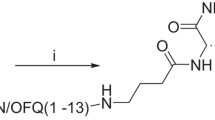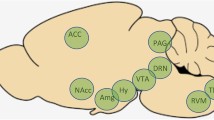Abstract
Nociceptin/orphanin FQ (N/OFQ) is the endogenous ligand for the N/OFQ peptide receptor (NOP). Binding studies have relied on [leucyl-3H]N/OFQ, but as this is an agonist G-protein coupling will affect affinity. In this paper, we describe a new [3H]labeled NOP antagonist, [Nphe1,4’-3H-Phe4,Arg14,Lys15]N/OFQ-NH2 ([3H]UFP-101). We have characterized [3H]UFP-101 at recombinant human NOP expressed in Chinese hamster ovary cells (CHOhNOP) and native rat NOP in cerebrocortex. Radioligand saturation and competition studies were performed on membranes, and [3H]UFP-101 (antagonist) was compared with [3H]N/OFQ (agonist). The effects of GTPγS (10 µM) and Na+ were investigated alone and in combination in competition experiments with both radioligands. In CHOhNOP, B max, and pK D, values were 561 and 580 fmol mg protein−1 and 9.97 and 10.19 for [3H]UFP-101 and [leucyl-3H]N/OFQ, respectively. In rat cerebrocortex B max and pK D, values were 65 and 88 fmol mg protein−1 and 10.12 and 10.34 for [3H]UFP-101 and [leucyl-3H]N/OFQ. The binding of both radioligands was displaced by a range of peptide and non-peptide NOP ligands at both isoforms with good correlation (r 2 0.92 in Rat and 0.97 in CHOhNOP). Naloxone was inactive. The binding of both radioligands was Na+-dependent with [3H]UFP-101 being more sensitive (IC50 ~20 mM). Unlike the agonist [leucyl-3H]N/OFQ, the antagonist [3H]UFP-101 was unaffected by GTPγS. [3H]UFP-101 binds to human and rat NOP with high affinity and good agreement with standard [leucyl-3H]N/OFQ in competition experiments. In addition, the binding of [3H]UFP-101 is unaffected by GTPγS. This radioligand will be useful to further characterize NOP in a range of binding paradigms.





Similar content being viewed by others
References
Albrecht E, Samovilova NN, Oswald S, Baeger I, Berger H (1998) Nociceptin (orphanin FQ): high-affinity and high-capacity binding site coupled to low-potency stimulation of guanylyl-5′-O-(gamma-thio)-triphosphate binding in rat brain membranes. J Pharmacol Exp Ther 286(2):896–902
Ardati A, Henningsen RA, Higelin J, Reinscheid RK, Civelli O, Monsma FJJ (1997) Interaction of [3H]Orphanin FQ and 125I-Tyr14-Orphanin FQ with the Orphanin Receptor: kinetics and modulation by cations and guanine nucleotides. Mol Pharmacol 51:816–824
Burgisser E, De Lean A, Lefkowitz RJ (1982) Reciprocal modulation of agonist and antagonist binding to muscarinic cholinergic receptor by guanine nucleotide. Proc Natl Acad Sci USA 79(6):1732–1736
Calo G, Guerrini R, Bigoni R, Rizzi A, Marzola G, Okawa H, Bianchi C, Lambert DG, Salvadori S, Regoli D (2000a) Characterization of [Nphe1]nociceptin(1-13)NH2, a new selective nociceptin receptor antagonist. Br J Pharmacol 129(6):1183–1193
Calo G, Guerrini R, Rizzi A, Salvadri S, Regoli D (2000b) Pharmacology of nociceptin and its receptor: a novel therapeutic target. Br J Pharmacol 129(7):1261–1283
Calo G, Rizzi A, Rizzi D, Bigoni R, Guerrini R, Marzola G, Marti M, McDonald J, Morari M, Lambert DG, Salvadori S, Regoli D (2002) [Nphe1,Arg14,Lys15]nociceptin-NH2, a novel potent and selective antagonist of the nociceptin/orphanin FQ receptor. Br J Pharmacol 136(2):303–311
Calo G, Guerrini R, Rizzi A, Salvadori S, Burmeister M, Kapusta DR, Lambert DG, Regoli D (2005) UFP-101, a peptide antagonist selective for the nociceptin/orphanin FQ receptor. CNS Drug Rev 11(2):97–112
Cheng Y, Prusoff WH (1973) Relationship between the inhibition constant (K1) and the concentration of inhibitor which causes 50 per cent inhibition (I50) of an enzymatic reaction. Biochem Pharmacol 22(23):3099–3108
Chiou LC, Liao YY, Fan PC, Wang CH, Riemer C, Prinsen EP (2007) Nociceptin/orphanin FQ peptide receptors: pharmacology and clinical implications. Curr Drug Targets 8:117–135
Dooley CT, Houghten RA (2000) Orphanin FQ/nociceptin receptor binding studies. Peptides 21(7):949–960
Gairin JE, Botanch C, Cros J, Meunier JC (1989) Binding of dynorphin A and related peptides to kappa- and mu-opioid receptors: sensitivity to Na+ ions and Gpp(NH)p. Eur J Pharmacol 172(4–5):381–384
Gavioli EC, Calo G (2006) Antidepressant- and anxiolytic-like effects of nociceptin/orphanin FQ receptor ligands. Naunyn Schmiedebergs Arch Pharmacol 372(5):319–330
Gether U, Lin S, Kobilka BK (1995) Fluorescent labeling of purified beta 2 adrenergic receptor. Evidence for ligand-specific conformational changes. J Biol Chem 270(47):28268–28275
Guerrini R, Calo G, Rizzi A, Bianchi C, Lazarus LH, Salvadori S, Temussi PA, Regoli D (1997) Address and message sequences for the nociceptin receptor: a structure–activity study of nociceptin-(1-13)-peptide amide. J Med Chem 40(12):1789–1793
Guerrini R, Calo G, Bigoni R, Rizzi D, Regoli D, Salvadori S (2001) Structure–activity relationship of [Nphe1]-NC-(1–13)-NH2, a pure and selective nociceptin/orphanin FQ receptor antagonist. J Pept Res 57(3):215–222
Guerrini R, Calo G, Lambert DG, Carra G, Arduin M, Barnes TA, McDonald J, Rizzi D, Trapella C, Marzola E, Rowbotham DJ, Regoli D, Salvadori S (2005) N- and C-terminal modifications of nociceptin/orphanin FQ generate highly potent NOP receptor ligands. J Med Chem 48(5):1421–1427
Hashiba E, Lambert DG, Farkas J, Toth G, Smith G (2002) Comparison of the binding of [3H]nociceptin/orphaninFQ(1-13)NH2, [3H]nociceptin/orphaninFQ(1-17)OH and [125I]Tyr14nociceptin/orphaninFQ(1-17)OH to recombinant human and native rat cerebrocortical nociceptin/orphanin FQ receptors. Neurosci Lett 328(1):5–8
Hawes BE, Graziano MP, Lambert DG (2000) Cellular actions of nociceptin: transduction mechanisms. Peptides 21(7):961–967
Horstman DA, Brandon S, Wilson AL, Guyer CA, Cragoe EJ Jr, Limbird LE (1990) An aspartate conserved among G-protein receptors confers allosteric regulation of alpha 2-adrenergic receptors by sodium. J Biol Chem 265(35):21590–21595
Johnson EE, Gibson H, Nicol B, Zanzinger J, Widdowson P, Hawthorn M, Toth G, Farkas J, Guerrini R, Lambert DG (2003) Characterization of nociceptin/orphanin FQ binding sites in dog brain membranes. Anesth Analg 97(3):741–747
Johnson EE, McDonald J, Nicol B, Guerrini R, Lambert DG (2004) Functional coupling of the nociceptin/orphanin FQ receptor in dog brain membranes. Brain Res 1003(1–2):18–25
Kenakin T (2003) Ligand-selective receptor conformations revisited: the promise and the problem. Trends Pharmacol Sci 24(7):346–354
Kitayama M, Barnes TA, Carra G, McDonald J, Calo G, Guerrini R, Rowbotham DJ, Smith G, Lambert DG (2003) Pharmacological profile of the cyclic nociceptin/orphanin FQ analogues c[Cys10,14]N/OFQ(1-14)NH2 and c[Nphe1,Cys10,14]N/OFQ(1-14)NH2. Naunyn Schmiedebergs Arch Pharmacol 368(6):528–537
Kong H, Raynor K, Yasuda K, Moe ST, Portoghese PS, Bell GI, Reisine T (1993) A single residue, aspartic acid 95, in the delta opioid receptor specifies selective high affinity agonist binding. J Biol Chem 268(31):23055–23058
Lambert DG (2008) The nociceptin/orphanin FQ receptor: a target with broad therapeutic potential. Nat Rev Drug Discov 7:694–710
Lowry OH, Nira J, Rosenbrough A, Farr L, Randall RJ (1951) Protein measurements with the Folin phenol reagent. J Biol Chem 193:265–275
McDonald J, Calo G, Guerrini R, Lambert DG (2003) UFP-101, a high affinity antagonist for the nociceptin/orphanin FQ receptor: radioligand and GTPgamma35S binding studies. Naunyn Schmiedebergs Arch Pharmacol 367(2):183–187
Meunier JC, Mollereau C, Toll L, Suaudeau C, Moisand C, Alvinerie P, Butour JL, Guillemot JC, Ferrara P, Monsarrat B et al (1995) Isolation and structure of the endogenous agonist of opioid receptor-like ORL1 receptor. Nature 377(6549):532–535
Mogil JS, Pasternak GW (2001) The molecular and behavioral pharmacology of the orphanin FQ/nociceptin peptide and receptor family. Pharmacol Rev 53(3):381–415
Neve KA, Cox BA, Henningsen RA, Spanoyannis A, Neve RL (1991) Pivotal role for aspartate-80 in the regulation of dopamine D2 receptor affinity for drugs and inhibition of adenylyl cyclase. Mol Pharmacol 39(6):733–739
New DC, Wong YH (2002) The ORL1 receptor: molecular pharmacology and signalling mechanisms. Neurosignals 11:197–212
Okada K, Sujaku T, Chuman Y, Nakashima R, Nose T, Costa T, Yamada Y, Yokoyama M, Nagahisa A, Shimohigashi Y (2000) Highly potent nociceptin analog containing the Arg-Lys triple repeat. Biochem Biophys Res Commun 278(2):493–498
Olianas MC, Onali P (2003) Sodium ions and GTP decrease the potency of [Nphe1]N/OFQ(1–13)NH2 in blocking nociceptin/orphanin FQ receptors coupled to cyclic AMP in N1E-115 neuroblastoma cells and rat olfactory bulb. Life Sci 72(25):2905–2914
Pert CB, Pasternak G, Snyder SH (1973) Opiate agonists and antagonists discriminated by receptor binding in brain. Science 182(119):1359–1361
Reinscheid RK, Nothacker HP, Bourson A, Ardati A, Henningsen RA, Bunzow JR, Grandy DK, Langen H, Monsma FJ Jr, Civelli O (1995) Orphanin FQ: a neuropeptide that activates an opioidlike G protein-coupled receptor. Science 270(5237):792–794
Rizzi D, Rizzi A, Bigoni R, Camarda V, Marzola G, Guerrini R, De Risi C, Regoli D, Calo G (2002) [Arg14,Lys15]nociceptin, a highly potent agonist of the nociceptin/orphanin FQ receptor: in vitro and in vivo studies. J Pharmacol Exp Ther 300(1):57–63
Rosenberger LB, Yamamura HI, Roeske WR (1980) Cardiac muscarinic cholinergic receptor binding is regulated by Na+ and guanyl nucleotides. J Biol Chem 255(3):820–823
Thomsen C, Valsborg JS, Platou J, Martin J, Foged C, Johansen NL, Olsen UB, Madsen K (2000) [3H]ac-RYYRWK–NH2, a novel specific radioligand for the nociceptin/orphanin FQ receptor. Naunyn Schmiedebergs Arch Pharmacol 362(6):538–545
Tóth G, Lovas S, Otvos F (1997) Tritium labelling of neuropeptides. In: Methods in Molecular Biology, Neuropeptide Protocols, Irvine, GB, Williams, CH (eds), pp 219–230
Trapella C, Guerrini R, Piccagli L, Calo G, Carra G, Spagnolo B, Rubini S, Fanton G, Hebbes C, McDonald J, Lambert DG, Regoli D, Salvadori S (2006) Identification of an achiral analogue of J-113397 as potent nociceptin/orphanin FQ receptor antagonist. Bioorg Med Chem 14(3):692–704
Varani K, Calo G, Rizzi A, Merighi S, Toth G, Guerrini R, Salvadori S, Borea PA, Regoli D (1998) Nociceptin receptor binding in mouse forebrain membranes: thermodynamic characteristics and structure activity relationships. Br J Pharmacol 125(7):1485–1490
Zeilhofer HU, Calo G (2003) Nociceptin/orphanin FQ and its receptor-potential targets for pain therapy? J Pharmacol Exp Ther 306:423–429
Acknowledgements
The authors would like to thank the International Association for the Study of Pain for provision of a collaborative travel grant between Universities of Leicester (UK) and Ferrara (Italy) and RET 08/2004, and OTKA T 46514 from National Bureau of Research and Technology (G.T.)
Author information
Authors and Affiliations
Corresponding author
Rights and permissions
About this article
Cite this article
Ibba, M., Kitayama, M., McDonald, J. et al. Binding of the novel radioligand [3H]UFP-101 to recombinant human and native rat nociceptin/orphanin FQ receptors. Naunyn-Schmied Arch Pharmacol 378, 553–561 (2008). https://doi.org/10.1007/s00210-008-0350-3
Received:
Accepted:
Published:
Issue Date:
DOI: https://doi.org/10.1007/s00210-008-0350-3




